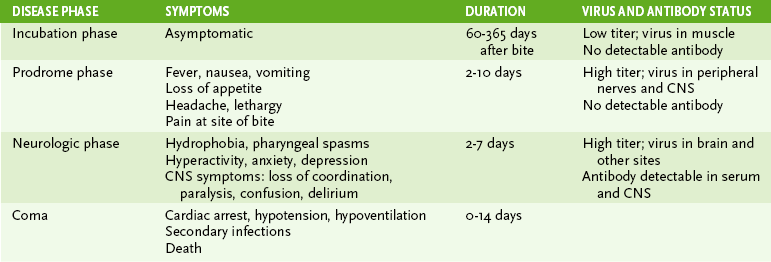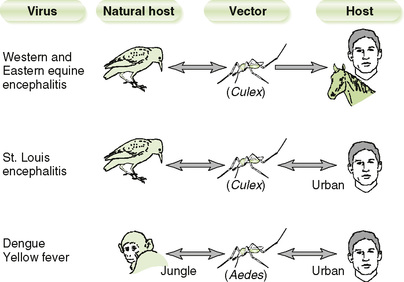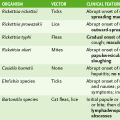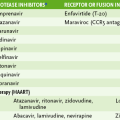Small and Midsized Enveloped RNA Viruses
1. This family comprises medium-sized, bullet-shaped viruses with an enveloped, helical nucleocapsid and single-stranded (–) RNA genome.
2. Only one significant human pathogen, rabies virus, is a rhabdovirus.
B Pathogenesis and disease progression (Table 25-1)
1. Rabies is a zoonotic disease, with unvaccinated domestic pets (dogs and cats) and wild skunks, raccoons (most common), and bats being the major reservoirs of the rabies virus.
2. The virus is transmitted to humans in saliva from an infected animal (via bite) or in aerosols from infected bats (via inhalation).
• Rabies virions bind to acetylcholine receptors on muscle cells at the site of the bite and enter target cells by endocytosis.
• The virus replicates within infected muscle cells.
• The duration of the incubation phase depends on the dose of virus received and the proximity of the bite to the brain.
• The virus infects peripheral nerves and travels through retrograde transport to the central nervous system (CNS).
• The virus spreads from the CNS through afferent neurons to highly innervated sites (e.g., glands, skin, and eyes).
• Virions are shed into saliva in the salivary glands.
• Infection of the brain leads to encephalitis with seizures and hydrophobia.
• Antibody response occurs only after the virus has infected the CNS and other sites, too late to prevent progression of the disease.
7. Coma and death are nearly always inevitable, unless prophylactic treatment is administered during incubation phase.
1. Rabies is diagnosed based on neurologic symptoms and history of an animal bite or contact with bats, with laboratory tests providing confirmation (Box 25-1).
2. Negri bodies (intracytoplasmic viral inclusions) are found in 70% to 90% of infected brains (animal or human).
3. Viral antigen in the CNS and brain is detectable by immunofluorescence at postmortem.
1. Preexposure vaccination of pets and high-risk personnel (veterinarians and animal handlers) is recommended.
2. Postexposure prophylaxis can prevent disease in infected people if instituted soon after exposure.
• Immediate cleansing of the wound reduces viral load.
• Active immunization with killed rabies vaccine is effective because of the long incubation period (>6 months).
• Passive immunization with equine antirabies serum or human rabies immune globulin provides protection until antibody is produced in response to vaccine.
II Other Zoonotic Enveloped (–) RNA Viruses
A Filoviridae: Ebola and Marburg viruses
1. Long, filamentous, enveloped viruses with a linear (–) RNA genome
2. Transmission and pathogenesis
• Transmission from monkeys to humans and also among humans by contact with infected body fluids or by accidental injection
• Viral glycoprotein initiates extensive tissue necrosis in the liver, lymph nodes, spleen, and lungs.
3. African hemorrhagic fever (Ebola fever and Marburg virus disease)
• Initial flu-like symptoms (headache and myalgia) are followed within a few days by nausea, vomiting, diarrhea, and possibly a maculopapular rash.
• Extensive hemorrhage, especially from the gastrointestinal tract, results in edema and hypovolemic shock, with death occurring in 50% to 90% of cases depending on strain.
• Virions have segmented (–) RNA genome
a. Virions carry nonfunctional cellular ribosomes, giving them a sandy appearance in electron micrographs.
• Aerosols, food, or fomites contaminated by feces or urine of infected rodents are routes for spreading virions to humans.
2. Lymphocytic choriomeningitis (LCM)
• Infection with the LCM virus causes a febrile flu-like illness with CNS involvement in about 25% of cases.
• Permanent neurologic damage in more than 25% with encephalitis
• Medium-sized, enveloped viruses with a segmented (–) RNA genome
• Most bunyaviruses are arboviruses, which are transmitted by insect vectors.
• Initial viremia following exposure causes flu-like symptoms.
• Secondary viremia spreads virions to target organs (e.g., CNS, liver, lungs, and vascular endothelium).
• Inhalation of infected rodent urine and feces transmits hantaviruses from infected animals to humans.
4. California encephalitis (e.g., La Crosse virus, California encephalitis virus)
• This arboviral disease is transmitted by a Culex mosquito that inhabits the forests of North America.
• Illness usually lasts about 1 week with a low fatality rate, although seizures occur in about half of cases.
5. Bunyaviral hemorrhagic fevers (e.g., Rift Valley fever virus, Crimean-Congo hemorrhagic fever virus)
III Togaviridae and Flaviviridae
1. These two families contain small, enveloped viruses with a single-stranded (+) RNA genome.
2. Except for rubella virus, all togaviruses are arboviruses.
3. Except for hepatitis C virus (see Chapter 27), all flaviviruses are arboviruses.
• Initial noncytolytic infection is established in the upper respiratory tract and then spreads to local lymph nodes.
• Viremia spreads virions to the skin and other tissues.
• Shedding of virions into respiratory droplets occurs during the 2-week prodromal period and for as long as 2 weeks after onset of the rash.
• Transplacental infection in nonimmune pregnant women leads to viral replication in fetal tissues and possible teratogenic effects due to alterations in fetal growth, mitosis, and chromosome structure.
• Antiviral antibody appears after viremia and helps limit virion spread.
2. Diseases due to rubella virus
a. In children, disease is benign, consisting of swollen glands and a pink maculopapular rash that lasts 3 days, starting on the face and spreading downward over the trunk and extremities.
b. In adults, disease is more severe, with arthralgia, arthritis, thrombocytopenia (rare), and possible postinfectious encephalitis due to the immune response.
C Togaviral and flaviviral arboviruses
• Bite of insect vector (usually a mosquito) injects virion-containing saliva into blood and initiates viremic spread.
• Initial infection is established primarily in macrophages and monocytes.
• Secondary viremia may occur, spreading infection to the brain, liver, vasculature, and skin.
2. Clinical syndromes associated with arboviral infections
• Most infections start with and may be limited to systemic flu-like symptoms.
• Tissue tropism of virus determines the nature of subsequent disease.
a. Caused by a flavivirus that is transmitted by an Aedes species mosquito in the Caribbean and Southeast Asia
b. Initial exposure causes high fever, headache, rash, and back and bone pain lasting 6 or 7 days.
c. Rechallenge with related strain can result in severe DHF and DSS.
a. Caused by a flavivirus that is transmitted by an Aedes species mosquito found mainly in tropical South America and Africa
b. Degeneration of the liver, kidneys, and heart can result in high mortality during epidemics.
c. High fever, jaundice, and “black vomit” due to gastrointestinal tract hemorrhage are common symptoms.
d. Councilman bodies (apoptotic acidophilic inclusions) are visible in liver.









